15 April 2017
How the Disappearing Arctic Ice is Already Changing Your Weather
Posted by Dan Satterfield
It’s called Arctic Amplification and it’s easy to understand. As the snow and ice disappear in the high latitudes, what was once bright and reflective, is now dark and warmer. Warmer because the solar energy it used to reflect is being absorbed, and this warming is not just a prediction, it’s been measured. The high latitudes are warming dramatically more than the tropical oceans.
But, how is this affecting our daily weather? This has been a question that is not easy to answer but a new paper in the AMS Journal of Climate has taken a new approach to the problem and the evidence is now strong that the loss of sea ice and snow cover is indeed altering the steering currents of the troposphere. I want you to understand this in a deeper way, so I need to explain the thermal wind and THEN I’ll tell you about the new research.
The Thermal Wind
If you go up 5 kilometres above your home in a balloon, not only will you find the temperature to be well below freezing but the winds will be from a westerly direction almost all of the time. I just checked the winds above my house here in Maryland (after I wrote the previous sentence) and they are NW at 40 mph. (Check your own winds at any time here).
How did I know this would be the case? Read on!
Thought experiment:
We have two ladders that are 5 km long. We put one up at Resolute Bay in the High Arctic and raise the other at Key West in Florida. Now, with their iPhones in hand Amy and Ginger climb up the ladder with a very good barometer on their back. When they get to the top, they each read their barometer, and what they will find is that the pressure 5km above sea level in Resolute Bay is much lower than it is at 5 km above Key West. Why? Think of it this way, the warm tropical atmosphere over the Keys is expanded by the warmth, so the pressure drops off more slowly as you climb, while the air thins more quickly in the cold troposphere over Resolute Bay. The higher you climb the bigger the pressure difference you will see between the two points and this is why the winds increase as you approach the top pf the troposphere!
What’s a poor little blob of air over Key West going to do about this?
That’s easy. Nature abhors a vacuum! The poor blob of air sees this huge drop in pressure to the north at Resolute Bay and rushes northward to fill the void. Unfortunately, It will never get there because the Earth is turning and the Coriolis force will turn the blob of air to the right so that it is rushing eastward. This is the thermal wind. The cold poles and warm tropics are why the winds blow from the west in the mid-latitudes. If you are still shaky about the thermal wind, this video may help.
Arctic Amplification and the Thermal Wind
The winds do not blow straight from the west all the time because there is unequal heating of the Earth’s surface (and Coriolis), and this causes “Rossby” waves to form. Look at the wind flow map below and you can see these waves at a height of about 5 km. Right where our ladders were.
Ask yourself a question. What happens if the temperature difference between the High Arctic and the tropics lessens? Since the Arctic is warming faster than the tropics due to Arctic amplification, this should cause the winds to decrease and when this happens we often see high and low-pressure centers form. This can cause the westerly winds to become less zonal (west to east) and more variable. When these “blocks” form, we often see extreme weather. Severe heat and drought or flooding rains. NOAA has a climate extremes index and it shows that indeed we do seem to be seeing increased extreme weather events.
Is Arctic amplification already altering the jet stream?
That’s the big question and one of the first scientists to try and answer it was my friend Dr Jennifer Francis at Rutgers University. The wind flow aloft should be getting weaker and it should be more “curvy”.
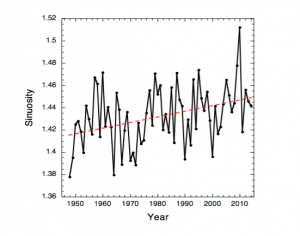
The “curviness” of the winds aloft is indeed increasing as expected. From:
Changes in North American Atmospheric Circulation and Extreme Weather: Influence of Arctic Amplification and Northern Hemisphere Snow Cover
Stephen J. Vavrus, Fuyao Wang, Jonathan E. Martin, Jennifer A. Francis, Yannick Peings, and Julien Cattiaux
DOI: http://dx.doi.org/10.1175/JCLI-D-16-0762.1
Dr Francis and 5 co-authors have a paper in an upcoming issue of the AMS Journal of Climate that shows that this indeed the case. The atmospheric flow is becoming wavier, and not only that, the newest climate models predict that it should be happening as the ice and snow disappear in the north. These models also show that it will all get dramatically worse by the end of this century as major changes develop in our weather patterns over North America. It looks like the wheat and corn belt in the Plains will be hit the hardest with much hotter and drier conditions, while winters may actually bring even stranger weather as blocks form and persist.
The Long and short of all this is…
The loss of Arctic ice and the past warming is now changing our day to day weather. It’s making extreme events more likely and more serious than they otherwise would be. This is the second paper published recently that shows changes underway in our overall weather patterns, so the evidence is really adding up. A good explainer of the paper by Chris Mooney at the Washington Post is worth a read.
How will this change our ability to grow crops that feed America (and much of the planet)? Will we see shifts that are so dramatic that the economic lifeblood of states like Kansas and Nebraska is gone with the hot and dusty wind? It looks likely if we fail to wean ourselves off of fossil fuels, but the real scary part is all the things that will likely happen, that we can only guess at. The question now is not “Did climate change cause this?”, but how big a role did it play in that drought/heat wave/snowstorm etc.?
The new paper is here. As I read it, I could not but think about this map showing where the greatest doubt exists over whether climate change is real. Note how many of those in the grain belt states believe all of the world’s top science bodies are wrong. Do you get it???
Those that may very well be impacted the most, are the most convinced it’s not happening!
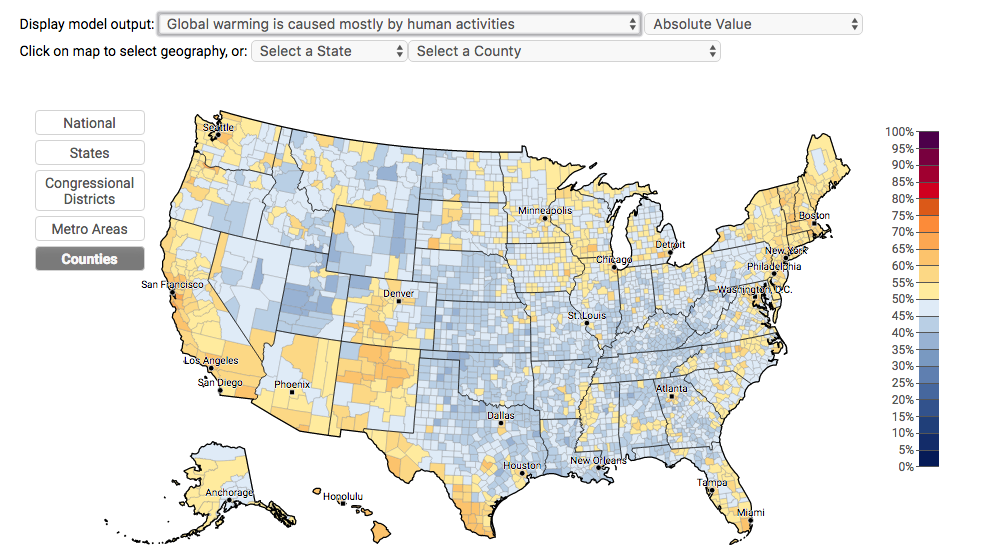
The yellow squares of acceptance surrounded by blue are college towns where a larger percentage of the population has a college degree. Click image for more about this map from Yale and George Mason Univ.
I know I spent a lot of time explaining the thermal wind, but to really understand what this paper is about, you need to know that. Hopefully, you found it interesting, and I must warn you that the maths behind it are not that easy (Here for fellow geeks). If you want to hear a lecture by one of the paper’s authors, it is below. It’s free, while the paper will cost you a subscription to the AMS journals!


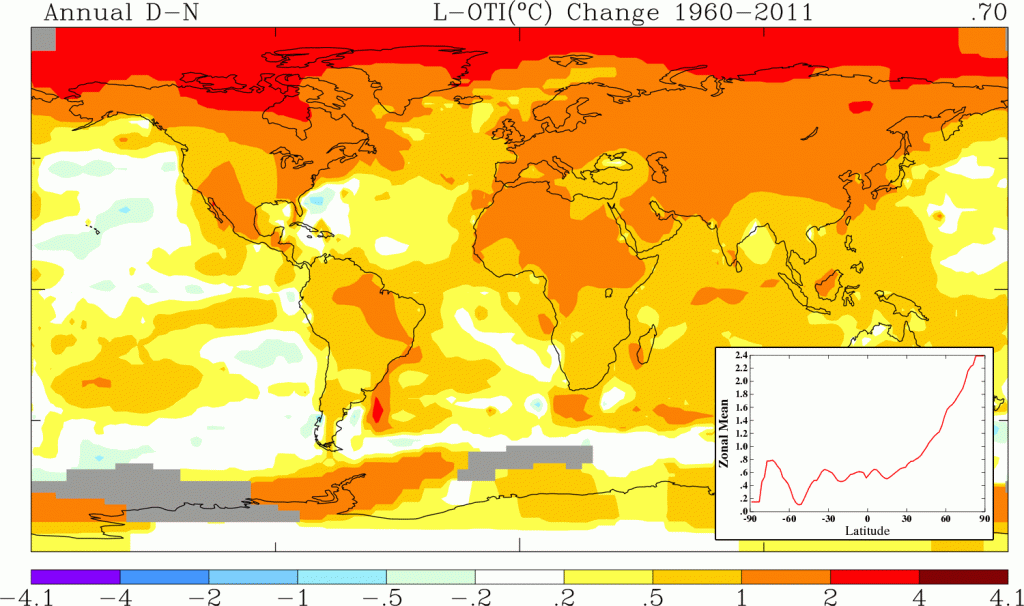
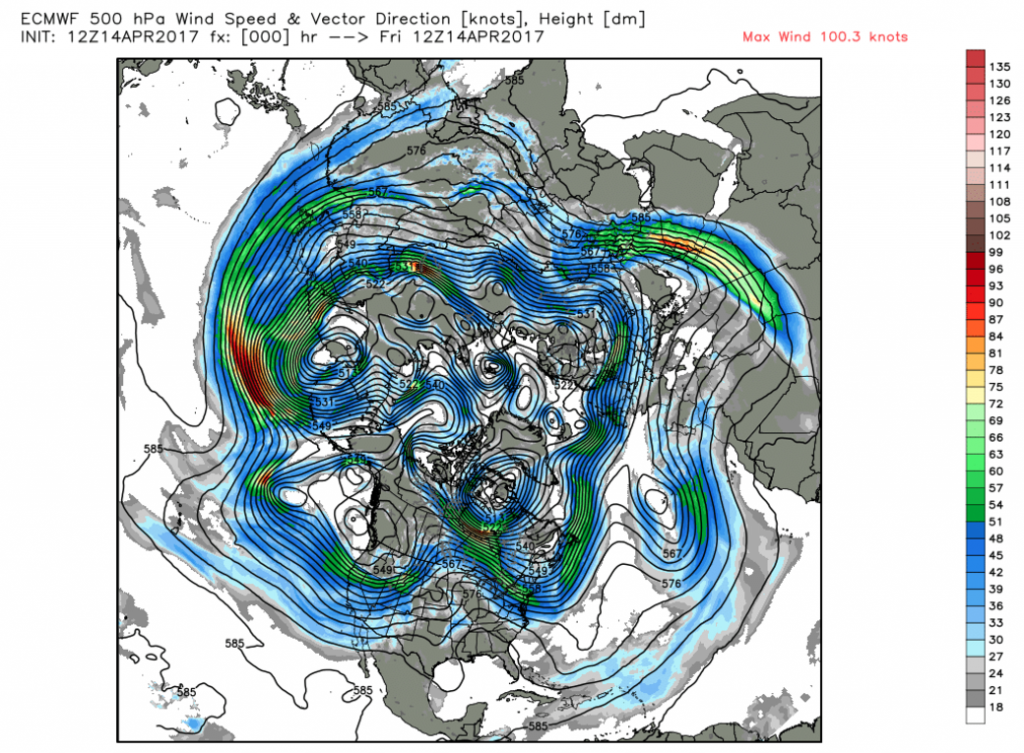
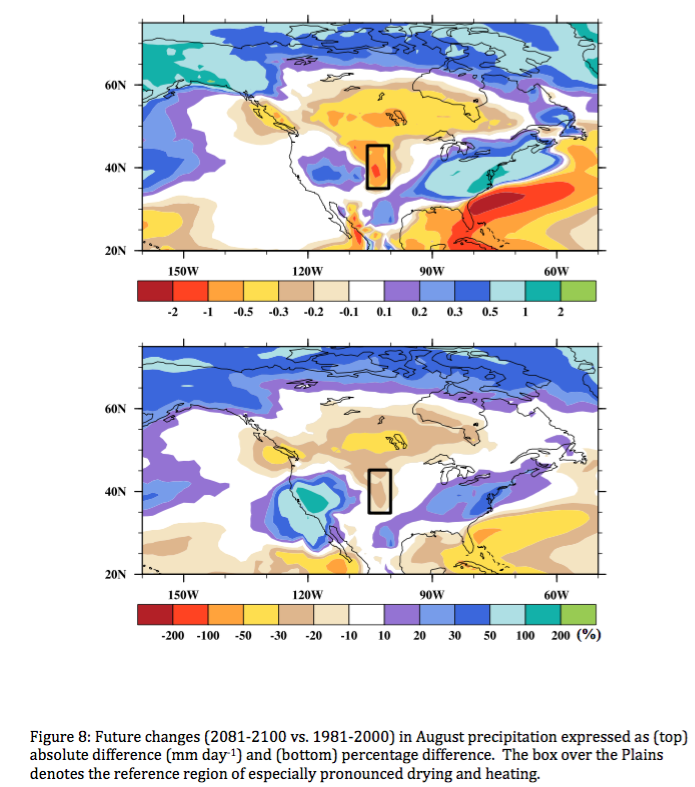
 Dan Satterfield has worked as an on air meteorologist for 32 years in Oklahoma, Florida and Alabama. Forecasting weather is Dan's job, but all of Earth Science is his passion. This journal is where Dan writes about things he has too little time for on air. Dan blogs about peer-reviewed Earth science for Junior High level audiences and up.
Dan Satterfield has worked as an on air meteorologist for 32 years in Oklahoma, Florida and Alabama. Forecasting weather is Dan's job, but all of Earth Science is his passion. This journal is where Dan writes about things he has too little time for on air. Dan blogs about peer-reviewed Earth science for Junior High level audiences and up.
I posted your article and this was the reply I received.
Re: It’s called Arctic Amplification – and it is not important to climate
Arctic amplification is not all that important. There are various reasons. The first is that during winter, when the ice extent is the greatest, the arctic is mostly gets very little sunlight or sunlight at a high angle. Such light is mostly reflected from oceans even if they are not covered in ice. Therefore, more ice and snow has a very marginal effect. On the other hand, more open water causes more rapid cooling of ocean water. That is because in the winter, air temperatures can be very low – much lower than the freezing point of ocean water. Open water in the winter in the arctic cools the ocean rapidly to some depth and cools it more than it otherwise would if there were ice above. Ice acts like an insulating blanket to the ocean. Once the ice starts forming, it causes sea salt to be released which causes a “hyper saline” movement of water downwards which in turn is partly what causes one of the large currents that helps keep Northern Europe with a warmer climate than it might otherwise have.
Where ice and snow have a much higher impact on temperature and cause much more amplification is in areas below the arctic circle especially land areas. That is because the sun hits at a much more perpendicular angle in the summer and still hits it during the winter.
How can the above be proven?
In the Medieval warm period, the Vikings lived in parts of Greenland that are today unlivable. In the parts of Greenland they lived, they arrived at a time when there were forests that would serve as fuel for fires and building materials. There were open grasslands that could be plowed to grow grains and gardens. The ocean routes to and from Greenland stayed ice free much longer than they do now. The arctic was warmer then than now and stayed so for hundreds of years. As the cooling began, the arctic got colder, ice stayed longer closing the shipping lanes to Greenland for longer and longer until some areas that were once harbors were no longer ice free even in summer.
Various types of proxy data for areas bordering the arctic oceans shows that the tree line (how far north trees have grown) varied considerably over time. Trees grew the farthest north showing more warmth in the arctic during the Holocene optimum several thousand years ago. Other periods such as the Roman Warm period also had the arctic ice free much farther north than it is now. The Medieval warm period while warmer than now, was not as warm as the Roman warm period or Holocene optimum.
Even during the 1940s, the arctic was more ice free than it is now. Thus, historical evidence proves that the ice varies in the arctic quite a bit naturally. Arctic amplification is as would be expected by any reasonable scientist from the basic physics is small. So small that changes in ice levels that occur periodically due to changes in the AMO, AO and PDO are not overpowering. Which is why the ice levels vary quite a bit naturally in the arctic but otherwise have little impact on world temperatures.
I’ve not heard the old “Greenland was warm enough for grapes” mythology in a while. That’s basically a summary of claims that were discredited 15-20 years ago. Another case of “I am right, but every major science body on Earth is wrong”, paired with ‘I can’t get what I think published because it’s a big conspiracy’. The greenhouse gases are currently adding about 1.5 watts per square meter of heat to the planet. That’s the physics. Nobody believes the Earth’s climate does not oscillate, but the gases are still causing the warming because the laws of physics are real, so any internal oscillations are added to the greenhouse warming. btw- many of the claims above about ice and how Greenland looked in medieval times are not backed up by research. They are just junk claims that seem to float around on the internet. Also, the medieval warm period was real, but it was not global. The climate was much different and actually drier in other regions. Esp. the American SW. Again, though, it would not matter if it were a global phenomenon. The greenhouse gases are still adding the heat. Critical thinking fail.
Wonderful job of explaining global warming
You can pick any time period you wish for the average. The most common are 1951-1980 since this is the period that most people alive now think of as normal, since they lived through it or part of it. We are also increasingly seeing the average of the entire 20th century used. It does not change the amount of temperature change over the period of record no matter what period you use. For instance, you can choose the last 30 years and says that the early 2oth century was much cooler than we are now.